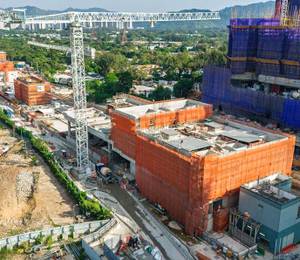The Department of Public Works and Highways (DPWH) has won the 2024 Going Digital Award in the Roads and Highways category for the NLEX-SLEX Connector Road Project (Caloocan to Manila) in the Philippines.
Bentley Systems announced the winners of the 2024 Going Digital Awards on 9 October, during the company’s Year in Infrastructure (YII) event held at the JW Marriott Parq Vancouver, Canada. The full list can be viewed here.
The annual awards honour the extraordinary work of infrastructure professionals and their innovative use of Bentley software to improve the way infrastructure is designed, built and operated. This year, 250 projects were nominated by organisations in 36 countries. The winners were selected from among 36 finalists in 12 categories by a panel of independent judges.
NLEX-SLEX Connector Road
Manila, one of the most densely populated metro areas in the world, suffers from significant road congestion – commuters lose nearly five days of their lives sitting in traffic each year, and average rush hour speeds are just 19 km per hour. To improve the situation, DPWH is developing an 8-km, all-elevated, high-speed road connecting major road networks in the north and south. Developing roads in a dense urban centre presented challenges, including right-of-way issues and limited space for construction equipment.
After considering several technologies, DPWH chose Bentley solutions to develop a mixed reality digital twin of the project. Using iTwin Capture, DPWH incorporated conditions in the field, then using OpenBridge and OpenRoads to create 3D models. With Bentley LumenRT and Synchro, DPWH visualised the construction process.
The adoption of digital solutions improved productivity by 15%, and boosted equipment logistics by 40%. The new road improves transportation of goods and reduces travel time by more than one hour, saving about 315 mil kg of equivalent carbon emissions per year.
Southeast Asian finalists
Three other companies working on prominent construction projects in Southeast Asia were among the finalists of this year’s Going Digital Awards. These included:
China Road and Bridge Corporation, China Highway Engineering Consulting Corporation
Phnom Penh – Bavet Expressway, Cambodia
(Roads and Highways category)
The Phnom Penh – Bavet Expressway is the second expressway in Cambodia, stretching 138 km and passing through three provinces. China Road and Bridge Corporation (CRBC) was tasked with constructing the expressway that would shorten travel times from two hours to 20 minutes. However, the project was located in a floodplain, with water reaching a maximum of 6 m during the rainy season. The team also needed to work around Buddhist temples and culture relics. Therefore, the team chose to implement digital delivery workflows.
CRBC established an open connected data environment using the iTwin Platform, ensuring that the team could always access the most up-to-date information at any time and any location. MicroStation, OpenRoads and OpenBridge helped develop models that could be shared with stakeholders. By using Bentley applications, everyone on the project worked together in a unified environment, shortening the design cycle by 20%. The terrain and geological models optimised vertical alignment, reducing earthwork volume by 2 mil cu m and the equivalent of 2.75 mil t of carbon emissions by eliminating truck travel.
PT Wijaya Karya (Persero)
Nusantara Presidential Complex, New Capital City of Indonesia
(Facilities, Campuses and Cities category)
Jakarta, the previous capital city of Indonesia, suffered from pollution, flooding and overcrowding. As a result, the country is building a new city, Nusantara, located in East Kalimantan. Part of its development includes a new, IDR 10.5 trillion presidential palace, which features a 50-MW solar plant and a facade featuring a Garuda bird, the symbol of Indonesia, with a wingspan of 117 m. Wijaya Karya had to develop the massive, complex project in a short timeframe.
Wijaya Karya adopted Bentley applications to design and model the project, starting with using iTwin Capture to process 9 ha of aerial site data. Next, the team used Bentley Open applications and MicroStation to model all elements of the site together, detecting and correcting clashes in the process. Digital modelling helped Wijaya Karya lower costs by US$63 million and lower the amount of rebar needed by 138.8 t, while also accelerating design by 33 days and determining ways to lower ongoing energy use.
PT Hutama Karya (Persero)
Jakarta MRT Phase 2A CP203, Indonesia
(Construction category)
Hutama Karya is delivering Phase 2A of Jakarta’s MRT, involving construction of two main underground stations. Upon completion, the rail line will enhance citywide connectivity and mobility, integrating with Jakarta’s entire transportation network to reduce traffic congestion and carbon emissions by up to 35%. Located in a dense urban area, the project presented site constraints and complicated ground conditions, demanding meticulous planning and scheduling. To address these issues, Hutama Karya needed a comprehensive, integrated digital solution.
The team selected Bentley Leapfrog and Plaxis for geotechnical modelling and analysis, Synchro for 4D planning and construction simulation, and ProjectWise and iTwin to establish a digital twin. Bentley’s geotechnical applications improved soil data collection and analysis by up to 95% and mitigated risks during excavation, saving up to US$2.5 million. Synchro 4D reduced heavy equipment use, promoting eco-friendly construction to save 50 t of carbon emissions. Through real-time digital collaboration and data analysis, Hutama Karya streamlined coordination and communication, slashing on-site operational inspection efforts by 90%.
Image 1: Bentley Systems
Image 2: Department of Public Works and Highways
Image 3: China Road and Bridge Corporation, China Highway Engineering Consulting Corporation
Image 4: PT Wijaya Karya
Image 5: PT Hutama Karya















